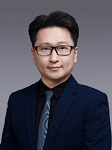- Newsroom
- Research Progress
- Academic Events
- Join Us
Harnessing biointerfacial property to control stem cell fate
Topic:Harnessing biointerfacial property to control stem cell fate
 Profile:Dr. Peng-Yuan Wang was awarded his PhD in Chemical Engineering on 2011, and subsequently worked as a SIEF Postdoctoral Fellow at Swinburne University of Technology and CSIRO. In 2015, he was awarded a prestigious ARC DECRA Fellowship for his work on nanopatterns and induced pluripotent stem cells (iPSCs). In 2018, he returned to Shenzhen and established the Stem Cell Bioengineering lab in Shenzhen Institute of Advanced Technology (SIAT), Chinese Academy of Sciences (CAS), supported by the Recruitment Program of Global Young Experts (One-Thousand Young Talent Program). He is the Director of the Shenzhen Key Laboratory of Biomimetic Materials and Cellular Immunomodulation.
Profile:Dr. Peng-Yuan Wang was awarded his PhD in Chemical Engineering on 2011, and subsequently worked as a SIEF Postdoctoral Fellow at Swinburne University of Technology and CSIRO. In 2015, he was awarded a prestigious ARC DECRA Fellowship for his work on nanopatterns and induced pluripotent stem cells (iPSCs). In 2018, he returned to Shenzhen and established the Stem Cell Bioengineering lab in Shenzhen Institute of Advanced Technology (SIAT), Chinese Academy of Sciences (CAS), supported by the Recruitment Program of Global Young Experts (One-Thousand Young Talent Program). He is the Director of the Shenzhen Key Laboratory of Biomimetic Materials and Cellular Immunomodulation.
Abstract:Manipulation of cell fate is a critical process in regenerative medicine and cell therapies. Strategies in maintaining the stemness of stem cells and directing stem cells into specific cell types are limited and inefficient. To date, a number of studies have reported that biophysical cues in the form of surface nanotopographies can influence stem cell attachment, proliferation, and differentiation. Specific surface nanotopographies can enhance the efficiency of cell reprogramming or maintain stemness of stem cells. While biochemical cues are generally efficient, biophysical cues have other advantages such as scalability, cost-effectiveness, longer lifetime, and easy to be defined. In our group, we fabricated biomimetic structures, including nanogrooves, nanopillars, nanopores, and colloidal crystals using various nanotechnologies. Our results show that controlling surface nanotopographies and chemistry can direct cell fate decisions, which reveals the fundamental questions in cell biology and benefits cell therapy. We believe that combining optimal biophysical cues with current biological approaches has great potential to generate functional cells and benefit regenerative medicine and cell therapies.
Time:November 11th
Location: Room 3#307
Speaker: Prof. Peng-Yuan Wang(中科院深圳先进技术研究院医药所)
Inviter: Prof. Junjie Deng
 Profile:Dr. Peng-Yuan Wang was awarded his PhD in Chemical Engineering on 2011, and subsequently worked as a SIEF Postdoctoral Fellow at Swinburne University of Technology and CSIRO. In 2015, he was awarded a prestigious ARC DECRA Fellowship for his work on nanopatterns and induced pluripotent stem cells (iPSCs). In 2018, he returned to Shenzhen and established the Stem Cell Bioengineering lab in Shenzhen Institute of Advanced Technology (SIAT), Chinese Academy of Sciences (CAS), supported by the Recruitment Program of Global Young Experts (One-Thousand Young Talent Program). He is the Director of the Shenzhen Key Laboratory of Biomimetic Materials and Cellular Immunomodulation.
Profile:Dr. Peng-Yuan Wang was awarded his PhD in Chemical Engineering on 2011, and subsequently worked as a SIEF Postdoctoral Fellow at Swinburne University of Technology and CSIRO. In 2015, he was awarded a prestigious ARC DECRA Fellowship for his work on nanopatterns and induced pluripotent stem cells (iPSCs). In 2018, he returned to Shenzhen and established the Stem Cell Bioengineering lab in Shenzhen Institute of Advanced Technology (SIAT), Chinese Academy of Sciences (CAS), supported by the Recruitment Program of Global Young Experts (One-Thousand Young Talent Program). He is the Director of the Shenzhen Key Laboratory of Biomimetic Materials and Cellular Immunomodulation. Abstract:Manipulation of cell fate is a critical process in regenerative medicine and cell therapies. Strategies in maintaining the stemness of stem cells and directing stem cells into specific cell types are limited and inefficient. To date, a number of studies have reported that biophysical cues in the form of surface nanotopographies can influence stem cell attachment, proliferation, and differentiation. Specific surface nanotopographies can enhance the efficiency of cell reprogramming or maintain stemness of stem cells. While biochemical cues are generally efficient, biophysical cues have other advantages such as scalability, cost-effectiveness, longer lifetime, and easy to be defined. In our group, we fabricated biomimetic structures, including nanogrooves, nanopillars, nanopores, and colloidal crystals using various nanotechnologies. Our results show that controlling surface nanotopographies and chemistry can direct cell fate decisions, which reveals the fundamental questions in cell biology and benefits cell therapy. We believe that combining optimal biophysical cues with current biological approaches has great potential to generate functional cells and benefit regenerative medicine and cell therapies.